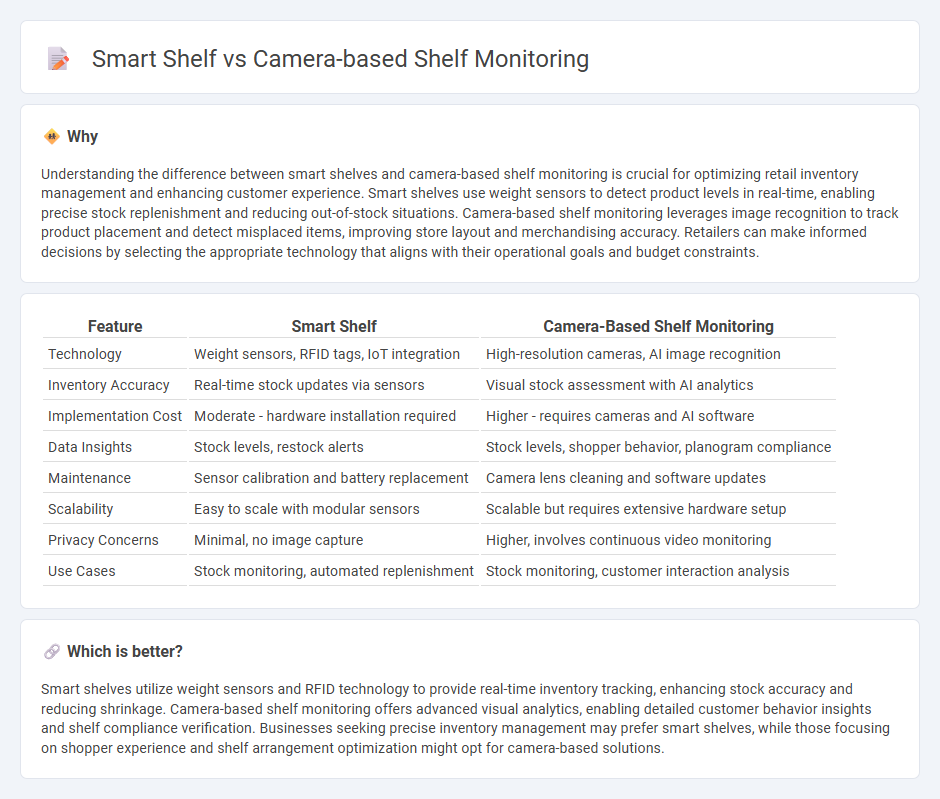
Smart shelves utilize embedded sensors to detect product levels and customer interactions in real-time, enhancing inventory accuracy and reducing out-of-stock situations. Camera-based shelf monitoring employs advanced image recognition technology to analyze shelf conditions and track shopper behavior, providing visually rich data for marketing and stock control. Discover how integrating these technologies can transform retail efficiency and customer experience.
Why it is important
Understanding the difference between smart shelves and camera-based shelf monitoring is crucial for optimizing retail inventory management and enhancing customer experience. Smart shelves use weight sensors to detect product levels in real-time, enabling precise stock replenishment and reducing out-of-stock situations. Camera-based shelf monitoring leverages image recognition to track product placement and detect misplaced items, improving store layout and merchandising accuracy. Retailers can make informed decisions by selecting the appropriate technology that aligns with their operational goals and budget constraints.
Comparison Table
| Feature | Smart Shelf | Camera-Based Shelf Monitoring |
|---|---|---|
| Technology | Weight sensors, RFID tags, IoT integration | High-resolution cameras, AI image recognition |
| Inventory Accuracy | Real-time stock updates via sensors | Visual stock assessment with AI analytics |
| Implementation Cost | Moderate - hardware installation required | Higher - requires cameras and AI software |
| Data Insights | Stock levels, restock alerts | Stock levels, shopper behavior, planogram compliance |
| Maintenance | Sensor calibration and battery replacement | Camera lens cleaning and software updates |
| Scalability | Easy to scale with modular sensors | Scalable but requires extensive hardware setup |
| Privacy Concerns | Minimal, no image capture | Higher, involves continuous video monitoring |
| Use Cases | Stock monitoring, automated replenishment | Stock monitoring, customer interaction analysis |
Which is better?
Smart shelves utilize weight sensors and RFID technology to provide real-time inventory tracking, enhancing stock accuracy and reducing shrinkage. Camera-based shelf monitoring offers advanced visual analytics, enabling detailed customer behavior insights and shelf compliance verification. Businesses seeking precise inventory management may prefer smart shelves, while those focusing on shopper experience and shelf arrangement optimization might opt for camera-based solutions.
Connection
Smart shelf technology integrates sensors and weight detectors to monitor inventory levels in real-time, while camera-based shelf monitoring uses image recognition and AI to track product placement and detect stockouts. Together, these systems enhance retail shelf management by providing comprehensive data on product availability, shelf compliance, and customer interactions. This combined approach optimizes inventory accuracy, reduces stock discrepancies, and improves overall store operational efficiency.
Key Terms
Computer Vision Analytics
Camera-based shelf monitoring utilizes computer vision analytics to capture real-time images and analyze product availability, placement, and shelf conditions, enabling precise stock management and loss prevention. Smart shelves integrate sensors and digital displays with computer vision for enhanced automated inventory tracking and consumer interaction, offering a more interactive and seamless retail experience. Explore the benefits and technologies behind these innovations by learning more about computer vision applications in retail.
Weight Sensor Technology
Weight sensor technology in camera-based shelf monitoring primarily captures accurate product weight data to detect stock levels and prevent theft. Smart shelves integrate weight sensors with IoT connectivity, enabling real-time inventory tracking and automated restocking alerts for improved operational efficiency. Explore how weight sensor innovations transform retail monitoring for enhanced accuracy and customer experience.
Real-time Inventory Tracking
Camera-based shelf monitoring leverages advanced image recognition algorithms to provide precise real-time inventory tracking by capturing and analyzing visual data from store shelves. Smart shelves integrate weight sensors and RFID technology to detect product removal and restocking, offering continuous updates on stock levels and enabling immediate inventory adjustments. Explore how these technologies revolutionize retail efficiency and customer experience by enhancing inventory visibility.
Source and External Links
How vision-based shelf monitoring helps retailers - e-con Systems - Camera-based shelf monitoring automates inventory tracking by capturing high-resolution images of store shelves, using AI to assess stock levels, planogram compliance, and promotional displays, thus improving stock accuracy and customer experience in retail.
Robot-Based Shelf Monitoring Cameras for Retail Operation Efficiency - Advanced camera systems integrated with autonomous robots perform real-time shelf monitoring for inventory tracking, planogram compliance, and shelf organization, enhancing operational efficiency and customer satisfaction.
Enhance Retail Efficiency with Focal's Shelf Cameras and AI Solutions - Focal offers wireless, battery-powered shelf cameras that scan retail shelves hourly, combined with AI to detect in-stock, out-of-stock, and low inventory items, digitizing shelves for actionable insights and improved store management.
 dowidth.com
dowidth.com